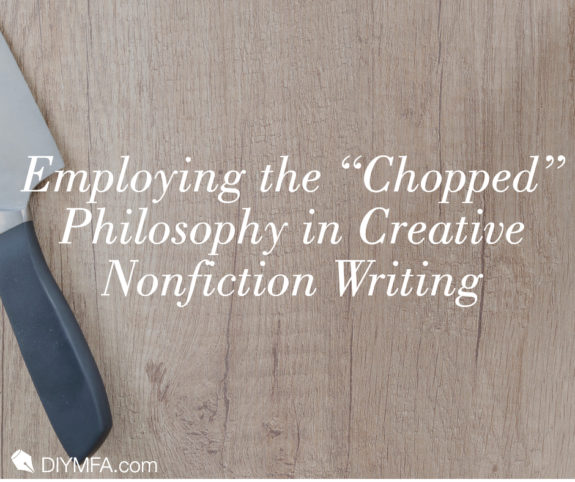“Chefs, please open your baskets.”
With those words, the competition on Chopped, my favorite Food Network show, where four chefs compete against each other in elimination-style appetizer, entree, and dessert rounds, begins
At the start of each round the chefs open baskets containing four ingredients that must be used in the dish—unusual ingredients such as gummy bears, sea buckthorn berries, crab aspic bowls, hot sauce packets, you get the idea. The chefs may also use ingredients from a nearby pantry and refrigerator to add more flavor and accent the dish. Those ingredients, however, are optional; the rule on Chopped is that the basket ingredients must be used. The chefs have to creatively use the ingredients they’ve been given in the basket to make the most appealing and delicious dish for the judges that they can.
Sounds very similar to the work of a creative nonfiction writer, doesn’t it?
Chopped and Creative Nonfiction
When writing creative nonfiction we must take what we have (facts, memories, data, research) and make use of other elements (description, dialogue, tension, pacing, etc.) in an effort to produce the most appealing and best book or article for the reader that we can.
Just like the chefs on Chopped, creative nonfiction writers use technique, engage the senses, and incorporate enough detail and flavor to keep the audience wanting more. But the essential ingredients—the facts—must be there. And just like it will be obvious to the judges on Chopped if an essential ingredient is missing (a big no-no), it will become apparent to readers if the essential ingredient of nonfiction writing—truth and facts—are missing. Obviously a big no-no as well.
As nonfiction writers, we start with what we know
In that way we are limited, more so than for those who write fiction where the scope of your imagination is your only limitation. And yet it’s also liberating to be able to say to myself, “Okay, this is what I have to work with; these are my boundaries. Now write.”
Perhaps that seems like a contradiction? How can a boundary be liberating? And yet, to someone like me, who would feel overwhelmed by the endless possibilities a fiction palette offers, this limitation allows me to dive in and start writing, knowing there are factual markers to help guide me. What I already know creates the frame on which I can begin to stretch my canvas. That doesn’t mean, of course, that I have no fear, nor do words just fly onto the page. But it’s something. It’s a start. And here’s where it gets exciting. This is where exploration and discovery begin.
With each writing session—with each thought and word expressed on the page—I explore, reaching deeper and deeper into events, conversations, and, perhaps seemingly meaningless happenings and incidental circumstances from my past. This exploration is what allows creative nonfiction writers to weave meaning out of truth.
The real beauty is what makes us want to write in the first place—to connect with readers. As we weave meaning out of our truth, the reader is weaving meaning out of theirs. In the best possible creative nonfiction writing scenario: our discoveries of meaning help readers bridge the gap between truth and meaning in their own lives. Therein lies the ideal for our creative nonfiction writing—universality.
A Journey to Meaning
In his essay, “Open Discovery in the Art of Creative Nonfiction” (Views from the Loft: A Portable Writer’s Workshop, edited by Daniel Slager, Milkweed Editions, July 29, 2010, pp. 316-317), Kim R. Stafford writes: “For the writer, as well as for the reader, creative nonfiction is the search for the most compelling story, or complex of stories, behind a given screen of information. We each … try to find the thread of story that makes it all matter. Because the raw material is fact, the writer and reader exist as partners in the open discovery of meaning.”
Dear fellow writers, I wish you all well in your writing … that is to say, in your own exploration and discovery of the meaning to be found in your stories, by both you and your readers.
This will be my final article for DIY MFA for a while. I’m going to devote my time to finishing my manuscript. To that end, I’m going to confront a fear I detailed in my very first article for DIY MFA.
I’ve decided to return to graduate school to complete my MFA in creative nonfiction. My fear has been—to tell my story openly and honestly. Common to many of us, right? And each of us has to find the best way to deal with it.
I’ve come to the realization—again—that I make much better progress in my writing within the structure and accountability of an MFA program (and a wonderful program it is: the MFA in Creative Nonfiction at Goucher College, Baltimore, MD). I have challenged myself to write my story … to face my fear and let it all spill out onto the page, then craft it into the best memoir I can.
I’m so grateful to Gabriela for the opportunity to have been a part of the DIY MFA team. I do hope to return in the future … this is such an awesome community! In the meantime, please feel free to check-in and/or subscribe to my newsletter at tessenterline.com. I plan to keep my newsletter going but cut it back to once a month. Thank you so much for reading my articles in this space over the past nine months.
And now, because I can’t help myself, I’d like to leave you with these words:
Writers, please open your laptops!

Tess Enterline is a creative nonfiction writer, currently working on her first memoir. She’s also a wife, mom, former hospital chaplain, dog lover, and fountain pen/stationery enthusiast (i.e., addict). You can visit her on her website at www.tessenterline.com.







